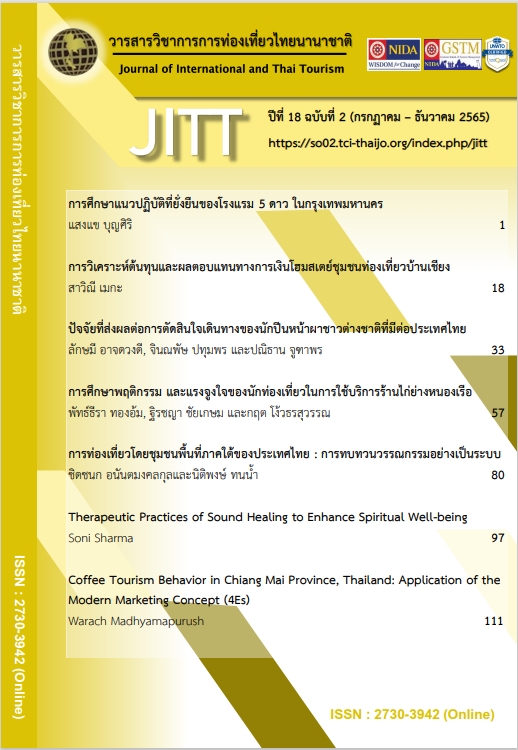ปัจจัยที่ส่งผลต่อการตัดสินใจเดินทางของนักปีนหน้าผาชาวต่างชาติที่มีต่อประเทศไทย Factors Influencing Foreign Climber’s the Decision to Travel in Thailand
Main Article Content
บทคัดย่อ
การศึกษาวิจัยนี้ มีวัตถุประสงค์เพื่อศึกษาปัจจัยที่ส่งผลต่อการตัดสินใจเดินทางของนักปีนหน้าผาชาวต่างชาติที่มีต่อประเทศไทย โดยการเก็บข้อมูลด้วยแบบสอบถามจาก กลุ่มตัวอย่างนักปีนหน้าผาชาวต่างชาติที่เคยเดินทางเข้ามาปีนหน้าผาในประเทศไทย จำนวน 200 ตัวอย่าง เก็บรวบรวมข้อมูลโดยการใช้แบบสอบถาม วิเคราะห์ข้อมูลโดยใช้ค่าร้อยละ ความถี่ค่าเฉลี่ย ค่าเบี่ยงเบนมาตรฐาน และวิเคราะห์องค์ประกอบเชิงยืนยัน (Confirmatory Factor Analysis: CFA) ซึ่งผลการศึกษาพบว่าปัจจัยที่ส่งผลต่อการตัดสินใจเดินทางของนักปีนหน้าผาชาวต่างชาติที่มีต่อประเทศไทย คือปัจจัยผลักดัน 6 ปัจจัย ได้แก่ 1) ความท้าทาย/ความเสี่ยง 2) การปลดปล่อยอารมณ์ความรู้สึก 3) การยอมรับ 4) ความคิดสร้างสรรค์ 5) ความเชื่ออำนาจควบคุมตนเอง 6) ลักษณะทางธรรมชาติ และปัจจัยดึงดูด 2 ปัจจัย ได้แก่ 1) สิ่งดึงดูดใจทางการท่องเที่ยว 2) สิ่งอำนวยความสะดวก
Article Details

อนุญาตภายใต้เงื่อนไข Creative Commons Attribution-NonCommercial-NoDerivatives 4.0 International License.
เอกสารอ้างอิง
เลิศพร ภาระสกุล. (2553). พฤติกรรมนักท่องเที่ยว. กรุงเทพฯ: มหาวิทยาลัยธุรกิจบัณฑิตย์.
___________ (2558). แรงจูงใจและทัศนคติที่ส่งผลต่อความพึงพอใจโดยรวมของนักท่องเที่ยวชาวจีนต่อการท่องเที่ยวประเทศไทย. : มหาวิทยาลัยธุรกิจบัณฑิตย์.
___________ (2558). พฤติกรรมนักท่องเที่ยว. กรุงเทพฯ: สำนักพิมพ์แห่งจุฬาลงกรณ์มหาวิทยาลัย.
เลิศพร ภาระสกุล. (2559). พฤติกรรมนักท่องเที่ยว. พิมพ์ครั้งที่ 3. กรุงเทพฯ: สำนักพิมพ์แห่งจุฬาลงกรณ์มหาวิทยาลัย
วัชราภรณ์ ระยับศรี. (2551). พฤติกรรมการท่องเที่ยวเชิงพุทธของนักท่องเที่ยวชาวไทยและต่างชาติที่มาเยือนวัดในบริเวณเกาะรัตนโกสินทร์ กรุงเทพมหานคร. ปริญญานิพนธ์วิทยาศาสตร์มหาบัณฑิต สาขาการวางแผนและการจัดการการท่องเที่ยวเพื่ออนุรักษ์สิ่งแวดล้อม บัณฑิตวิทยาลัย มหาวิทยาลัยศรีนครินทรวิโรฒ.
สุรีรัตน์ เตาชาทวีวรรณ. (2545). เอกสารประกอบการสอน วิชาพฤติกรรมนักท่องเที่ยว (Tourism Behavior). ขอนแก่น: มหาวิทยาลัยขอนแก่น.
อัศวิน แสงพิกุล. (2552). การเปรียบเทียบแรงจูงใจในการเดินทางท่องเที่ยวระหว่างนักท่องเที่ยวชาวเอเชียและนักท่องเที่ยวชาวยุโรป: มหาวิทยาลัยธุรกิจบัณฑิตย์.
Adeleke. (2015). Motivation of tourists through marketing strategies of Olumo rock tourist complex. European Journal of Hospitality and Tourism Research, 3(2), pp. 39-46.
Amy Miller Ansari. (2008). Understanding the motivation of rock climbers: A social worlds study. University of Nevada Las Vegas.
Asçı, F. H., Demirhan, G., & Dinç, S. (2007). Psychological profile of Turkish climbers: An examination of climbing experience and route difficulty. Perceptual and Motor Skills, 104, 892-900.
Beckman, (2013). The impact of motivation and enduring involvement in an adventure tourism setting. University of Tennessee, Knoxville, USA.
Chon, K. (1989). Understanding Recreational Travelers’ Motivation, Attitude and Satisfaction. The Tourist Review, 44(1), 3-7.
Climbingworrior. (2561). Rock Climbing กีฬาปีนหน้าผาคือ. ค้นเมื่อ 30 กรกฎาคม 2562, จาก http://www.climbingwarrior.com/2018/10/rock-climbing.html
Csikszentmihalyi M. (1990). Flow: The Phycology of Optimal Experience. New York: Harper & Row.
Crompton, J. (1979). motivation for pleasure vocation. Annals of Tourism Research, 6, 408-424.
Dann, G. M. S. (1981). Tourist Motivation: An Appraisal. Annuals of Tourism Research, 9(2), 187-219.
David Flanagan. (2013). Bouldering for beginners. Published by Three Rock Books.
Dickman. (1996). Tourism: An Introductory Text. 2nd ed. Sydney: Hodder Education.
Ewert A. (1985). Why people Climb: The Relationship of Participant Motivation and Experience Level to Mountaineering. Journal of Leisure Research, 17(3), 241-250.
Ewert, A., Gibertson, K., Luo, Y. C., & Voight, A (2013). Beyond “because it’s there”: motivations for pursuing adventure recreational activities. Journal of Leisure Research, 44(1), 91e111.
Extreme Sport Skydrive. (2017). ความนิยมของ Rock climbing หรือ กีฬาปีนหน้าผา. ค้นเมื่อ 30 กรกฎาคม 2560, จาก http://www.challengersjv.org/ความนิยมของ-rock-climbing-หรือ-กีฬาป/
Fave, Bassi, Massimini. (2003). Quality of experience and risk perception in high-altitude rock climbing. Journal of Applied Sport Psychology, pp.82-98.
Gibson, H.J. (2004). Moving beyond the “what is and who” of sport tourism to understanding “why”. Journal of sport & Tourism, 9(3), 247-265.
Hardly, L., & Hutchinson, A. (2007). Effects of performance anxiety on effort and performance in rock climbing: a test of processing efficiency theory. Anxiety, Stress, and Coping, 20(2), 147-161. https://doi.org/10.1080/10615800701217035
Heywood, (2006). Climbing monsters: excess and restraint in contemporary rock climbing, Leisure Studies, 25(4), pp.455-467.
Hudman, L.E. (1980). Tourism: A Shining World. Ohio: Grid.
Iso-Ahola, S. (1990). Motivation Foundations of Leisure. In. F., L. Jackson & T. L. Burton (Eds), Leisure Studies: Prospects for the Twenty-First Century. State College, Pennsylvania.
Iso-Ahola, S. (1999). Motivation Foundations of Leisure. In. F., L. Jackson & T. L. Burton (Eds), Leisure Studies: Prospects for the Twenty-First Century. (pp. 39-49). Stage College, Pennsylvania: Venture Publishing, Inc.
John Swarbrooke, Colin Beard, Suzanne Leckie, Gill Pomfret. (2003). Adventure Tourism The new frontier. Oxford: Butterworth-Heinemann.
Khuong, M. N., & Ha, H. T. T. (2014). The Influences of Push and Pull Factors on the International Leisure Tourism’ Return Intention to Ho Chi Minh City, Vietnam-A Mediation Analysis of Destination Satisfaction. International Journal of Trade, Economics and Finance, 5(6), 490-496.
Kulczycki. (2014). Place meanings and rock climbing in outdoor settings. Journal of Outdoor Recreation and Tourism, 7-8, pp. 8-15.
Lee, T. H., & Hsu, F. Y. (2013). Examining How Attending Motivation and Satisfaction Affects the Loyalty for Attendees at Aboriginal Festivals. International Journal of Tourism Research. Retrieved April 1, 2012, from http://onlinelibrary.wiley.com/doi/10.1002/jtr.867/pdf
Llewellyn, X. Sanchez, A. Asghar, G. Jones. (2008). Self-efficacy, risk taking and performance in rock climbing. Personality and Individual Differences, pp. 75-81.
Merrill and Graefe. (2007). The relationship between activity specialization and preferences for setting and route attributes of selected rock climbers. Proceedings of the 1997 northeastern recreation research symposium, Bolton Landing, New York, USA, pp. 40-44.
Mohammad, B. A. M. A., A.-H., & Som, A. P. M. (2010). An Analysis of Push and Pull Travel Motivations of Foreign Tourists to Jordan. International Journal of Business and Management, 5(12), 41-50.
Monz, Smith, Knickerbocker. (2005). Climbers’ attitudes toward recreation resource impacts in the Adirondack Park. Proceedings of the 2005 northeastern recreation research symposium, Bolton Landing, New York, USA, pp. 204-211.
Pizam, A., Neumann, Y. & Reichel, A. (1979). Tourism Satisfaction. Annals of Tourism Research, 6, 195-197.
Robinson. (1985). Stress seeking: Behavioral characteristics of elite rock climber. Journal of Sport Psychology, pp. 400-404.
Rid, W., Ezeuduji, I. O. & Probstl-Haider, U. (2014). Segmentation by Motivation for Rural Tourism Activities in The Gambia. Tourism Management. 40, 102-116.
Slanger, E. and K. E. Rudestam. 1997. Motivation and Disinhibition in High Risk Sport: Self- Seeking and Self-Efficacy. Journal of Research in Personality, 31: 355-374.
Uysal, M and Hagan, L.A.R. (1993) “Motivation of pleasure travel and tourism”. In: Kham, M.A., Olsen, M.D. and Turgut, V. (eds) Encyclopedia of Hospitality and Tourism. Van Nostrand Reinhold, New York, pp. 798-821.


